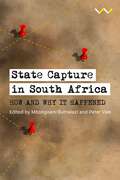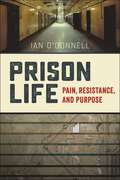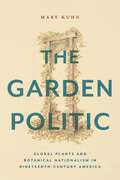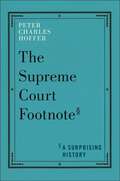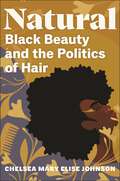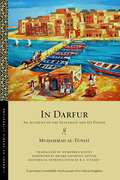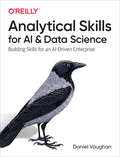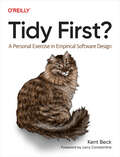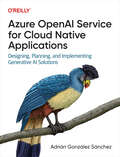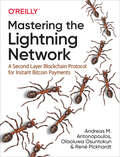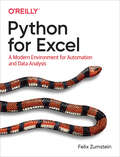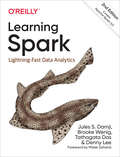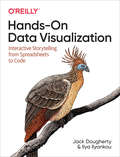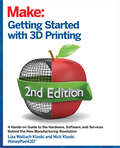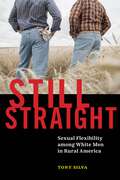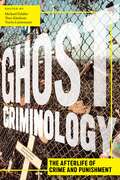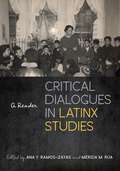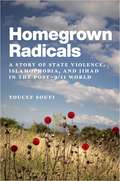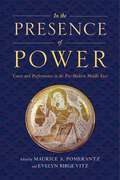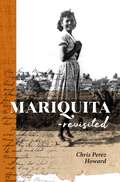- Table View
- List View
State Capture in South Africa: How and why it happened
by Jonathan Klaaren Karl von Holdt Mbongiseni Buthelezi Peter Vale Robyn Foley Ryan Brunette Cherese Thakur Devi Pillay Luke Spiropoulos Reg Rumney Sizwe Mpofu-Walsh Michael Marchant Hennie van Vuuren Patrick Heller Barney PityanaA multidisciplinary analysis of how state capture unfolded in South Africa and was contested within both civil society and the state itself. It presents a scholarly and empirical understanding of how things went awry, even with various regulating bodies in place, and how to prevent state capture from happening again in the future.The metaphor of ‘state capture’ has dominated South Africa’s political discourse in the post-Zuma presidency era. What is state capture and how does it manifest? Is it just another example of a newly independent, failed African state? And is it unique to South Africa? The contributors in this collection try to explain the phenomenon from a variety of viewpoints and disciplines. All hold fast to the belief that the democracy that promised the country so much when apartheid ended has been significantly eroded, resulting in most citizens expressing a loss of hope for the future. Read together, the essays cumulatively show not only how state capture was enabled and who benefitted, but also how and by whom it was scrutinised and exposed in order to hold those in power accountable. The book aims to present a scholarly and empirical understanding of how things went awry, even with various regulating bodies in place, and how to prevent state capture from happening again in the future.
Prison Life: Pain, Resistance, and Purpose
by Ian O'DonnellHow prisons around the world shape the social lives of their inhabitantsPrison Life offers a fresh appreciation of how people in prison organize their lives, drawing on case studies from Africa, Europe and the US. The book describes how order is maintained, how power is exercised, how days are spent, and how meaning is found in a variety of environments that all have the same function – incarceration – but discharge it very differently. It is based on an unusually diverse range of sources including photographs, drawings, court cases, official reports, memoirs, and site visits.Ian O’Donnell contrasts the soul-destroying isolation of the federal supermax in Florence, Colorado with the crowded conviviality of an Ethiopian prison where men and women cook their own meals, seek opportunities to generate an income, elect a leadership team, and live according to a code of conduct that they devised and enforce. He explores life on wings controlled by the Irish Republican Army in Northern Ireland’s H Blocks, where men who saw the actions that led to their incarceration as politically-motivated moved as one, in perpetual defiance of the authorities. He shows how prisoners in Texas took to the courts to overthrow a regime that allowed their routine subjugation by violent men known as building tenders, who had been selected by staff to supervise and discipline their peers.In each case study O’Donnell presents the life story of a man who was molded by, and in return molded, the institution that held him. This ensures that his reflections on law and policy as well as on theory and practice never lose sight of the human angle. Imprisonment is about pain after all, and pain is personal.
The Political Thought of America’s Founding Feminists
by Lisa Pace VetterRecovering the powerful and influential contributions of women from the nation’s formative yearsThe Political Thought of America’s Founding Feminists traces the significance of Frances Wright, Harriet Martineau, Angelina and Sarah Grimké, Lucretia Mott, Elizabeth Cady Stanton, and Sojourner Truth in shaping American political thinking. These women understood the relationship between sexism, racism, and economic inequality; yet, they are virtually unknown in American political thought because they are considered activists, not theorists. Their efforts to expand the reach of America’s founding ideals laid the groundwork not only for women’s suffrage and the abolition of slavery, but for the broader expansion of civil, political, and human rights that would characterize much of the twentieth century and continues to unfold today. Drawing on a careful reading of speeches, letters and other archival sources, Lisa Pace Vetter shows the ways in which the early women’s rights movement and abolitionism were central to the development of American political thought. The Political Thought of America’s Founding Feminists demonstrates that early American political thought is incomplete without attention to these important female thinkers, and that an understanding of early American women’s movements is incomplete without considering its profound impact on political thought. A complex and thoughtful guide to the indispensable role of women in shaping the American way of life, The Political Thought of America’s Founding Feminists is essential for a comprehensive understanding of the history of American political thought.
The Garden Politic: Global Plants and Botanical Nationalism in Nineteenth-Century America (America and the Long 19th Century #27)
by Mary KuhnHow worldwide plant circulation and new botanical ideas enabled Americans to radically re-envision politics and societyThe Garden Politic argues that botanical practices and discourses helped nineteenth-century Americans engage pressing questions of race, gender, settler colonialism, and liberal subjectivity. In the early republic, ideas of biotic distinctiveness helped fuel narratives of American exceptionalism. By the nineteenth century, however, these ideas and narratives were unsettled by the unprecedented scale at which the United States and European empires prospected for valuable plants and exchanged them across the globe. Drawing on ecocriticism, New Materialism, environmental history, and the history of science—and crossing disciplinary and national boundaries—The Garden Politic shows how new ideas about cultivation and plant life could be mobilized to divergent political and social ends. Reading the work of influential nineteenth-century authors from a botanical perspective, Mary Kuhn recovers how domestic political issues were entangled with the global circulation and science of plants. The diversity of Harriet Beecher Stowe’s own gardens contributed to the evolution of her racial politics and abolitionist strategies. Nathaniel Hawthorne’s struggles in his garden inspired him to write stories in which plants defy human efforts to impose order. Radical scientific ideas about plant intelligence and sociality prompted Emily Dickinson to imagine a human polity that embraces kinship with the natural world. Yet other writers, including Frederick Douglass, cautioned that the most prominent political context for plants remained plantation slavery. The Garden Politic reveals how the nineteenth century’s extractive political economy of plants contains both the roots of our contemporary environmental crisis and the seeds of alternative political visions.
The Supreme Court Footnote: A Surprising History
by Peter Charles HofferA history of the humble footnote and its impact on the highest court in the landIn May 2022, a seismic legal event occurred as the draft majority opinion in Dobbs v. Jackson Women’s Health was leaked. The majority aimed to eliminate constitutional protection for abortion. Amidst the fervor, an unnoticed detail emerged: over 140 footnotes accompanied the majority opinion and dissent. These unassuming annotations held immense significance, unveiling justices’ beliefs about the Constitution’s essence, highlighting their controversial reasoning, and laying bare the vastly different interpretations of the role of Supreme Court Justice.The Supreme Court Footnote offers a study of the evolution of footnotes in US Supreme Court opinions and how they add to our constitutional understanding. Through a comprehensive analysis, Peter Charles Hoffer argues that as justices alter the course of history via their decisions, they import their own understandings of it through the footnotes. The book showcases how the role of the footnote within Supreme Court opinions has evolved, beginning with one of the first cases in the history of the court, Chisholm v. Georgia in 1792 (a case concerning federalism vs. states’ rights) and ending with the landmark Dobbs v. Jackson case in 2022. Along the way, Hoffer demonstrates how the footnotes within these decisions reflect the changing role of the Supreme Court Justice, along with how interpretations of the constitution have transformed over time.At once surprising and revealing, The Supreme Court Footnote proves that what appears below the line is not only a unique window into the history of constitutional law but also a source of insight as to how the court will act going forward.
Natural: Black Beauty and the Politics of Hair
by Chelsea Mary JohnsonHow Black women celebrate their natural hair and uproot racialized beauty standardsHair is not simply a biological feature; it’s a canvas for expression. Hair can be cut, colored, dyed, covered, gelled, waxed, plucked, lasered, dreadlocked, braided, and relaxed. Yet, its significance extends beyond mere aesthetics. Hair can carry profound moral, spiritual, and cultural connotations, serving as a reflection of one’s beliefs, heritage, and even political stance. In Natural, Chelsea Mary Elise Johnson delves into the complex world surrounding Black women’s hair, and offers a firsthand look into the kitchens, beauty shops, conventions, and blogs that make up the twenty-first century natural hair movement, the latest evolution in Black beauty politics.Johnson shares her own hair story and amplifies the voices of women across the globe who, after years of chemically relaxing their hair, return to a “natural” style. Johnson describes how many women initially transition to natural hair out of curiosity or as a wellness practice but come to view their choice as political upon confronting personal insecurities and social stigma, both within and outside of the Black community. She also investigates “natural hair entrepreneurs,” who use their knowledge to create lucrative and socially transformative haircare ventures.Distinct from a politics of respectability or Afrocentricity, Johnson’s argument is that today’s natural hair movement advances a politics of authenticity. She offers “going natural” as a practice of self-love and acceptance; a critique of exclusionary economic arrangements and an exploitative beauty industry; and an act of anti-racist political resistance.Natural powerfully illustrates how the natural hair movement is part of a larger social change among Black women to assert their own purchasing power, standards of beauty, and bodily autonomy.
The Forbidden Body: Sex, Horror, and the Religious Imagination
by Douglas E. CowanFrom creature features to indie horror flicks, find out what happens when sex, horror, and the religious imagination come togetherThroughout history, religion has attempted to control nothing so much as our bodies: what they are and what they mean; what we do with them, with whom, and under what circumstances; how they may be displayed—or, more commonly, how they must be hidden. Yet, we remain fascinated, obsessed even, by bodies that have left, or been forced out of, their “proper” place. The Forbidden Body examines how horror culture treats these bodies, exploring the dark spaces where sex and the sexual body come together with religious belief and tales of terror.Taking a broad approach not limited to horror cinema or popular fiction, but embracing also literary horror, weird fiction, graphic storytelling, visual arts, and participative culture, Douglas E. Cowan explores how fears of bodies that are tainted, impure, or sexually deviant are made visible and reinforced through popular horror tropes. The volume challenges the reader to move beyond preconceived notions of religion in order to decipher the “religious imagination” at play in the scary stories we tell over and over again. Cowan argues that stories of religious bodies “out of place” are so compelling because they force us to consider questions that religious belief cannot comfortably answer: Who are we? Where do we come from? Why do we suffer? And above all, do we matter? As illuminating as it is unsettling, The Forbidden Body offers a fascinating look at how and why we imagine bodies in all the wrong places.
In Darfur: An Account of the Sultanate and Its People (Library of Arabic Literature #70)
by Muḥammad al-TūnisīA merchant’s remarkable travel account of an African kingdomMuḥammad al-Tūnisī (d. 1274/1857) belonged to a family of Tunisian merchants trading with Egypt and what is now Sudan. Al-Tūnisī was raised in Cairo and a graduate of al-Azhar. In 1803, at the age of fourteen, al-Tūnisī set off for the Sultanate of Darfur, where his father had decamped ten years earlier. He followed the Forty Days Road, was reunited with his father, and eventually took over the management of the considerable estates granted to his father by the sultan of Darfur.In Darfur is al-Tūnisī’s remarkable account of his ten-year sojourn in this independent state, featuring descriptions of the geography of the region, the customs of Darfur’s petty kings, court life and the clothing of its rulers, marriage customs, eunuchs, illnesses, food, hunting, animals, currencies, plants, magic, divination, and dances. In Darfur combines literature, history, ethnography, linguistics, and travel adventure, and most unusually for its time, includes fifty-two illustrations, all drawn by the author.In Darfur is a rare example of an Arab description of an African society on the eve of Western colonization and vividly evokes a world in which travel was untrammeled by bureaucracy, borders were fluid, and startling coincidences appear almost mundane.An English-only edition.
Analytical Skills for AI and Data Science: Building Skills for an AI-Driven Enterprise
by Daniel VaughanWhile several market-leading companies have successfully transformed their business models by following data- and AI-driven paths, the vast majority have yet to reap the benefits. How can your business and analytics units gain a competitive advantage by capturing the full potential of this predictive revolution? This practical guide presents a battle-tested end-to-end method to help you translate business decisions into tractable prescriptive solutions using data and AI as fundamental inputs.Author Daniel Vaughan shows data scientists, analytics practitioners, and others interested in using AI to transform their businesses not only how to ask the right questions but also how to generate value using modern AI technologies and decision-making principles. You’ll explore several use cases common to many enterprises, complete with examples you can apply when working to solve your own issues.Break business decisions into stages that can be tackled using different skills from the analytical toolboxIdentify and embrace uncertainty in decision making and protect against common human biasesCustomize optimal decisions to different customers using predictive and prescriptive methods and technologiesAsk business questions that create high value through AI- and data-driven technologies
Tidy First?: A Personal Exercise in Empirical Software Design
by Kent BeckTidying up messy software is a must. And that means breaking up the code to make it more readable, and using guard clauses and helping functions to make it understandable. In this practical guide, author Kent Beck, creator of Extreme Programming and pioneer of software patterns, suggests when and where you might apply tidyings in your code.Instead of trying to master tidying all at once, this book lets you try out a few examples that make sense for your problem. If you have a big function containing many lines of code, you'll learn how to logically divide it into smaller chunks. Along the way, you'll learn the theory behind software design: coupling, cohesion, discounted cash flows, and optionality.
Azure OpenAI Service for Cloud Native Applications: Designing, Planning, and Implementing Generative AI Solutions
by Adrián González SánchezGet the details, examples, and best practices you need to build generative AI applications, services, and solutions using the power of Azure OpenAI Service. With this comprehensive guide, Microsoft AI specialist Adrián González Sánchez examines the integration and utilization of Azure OpenAI Service—using powerful generative AI models such as GPT-4 and GPT-4o—within the Microsoft Azure cloud computing platform.To guide you through the technical details of using Azure OpenAI Service, this book shows you how to set up the necessary Azure resources, prepare end-to-end architectures, work with APIs, manage costs and usage, handle data privacy and security, and optimize performance. You'll learn various use cases where Azure OpenAI Service models can be applied, and get valuable insights from some of the most relevant AI and cloud experts.Ideal for software and cloud developers, product managers, architects, and engineers, as well as cloud-enabled data scientists, this book will help you:Learn how to implement cloud native applications with Azure OpenAI ServiceDeploy, customize, and integrate Azure OpenAI Service with your applicationsCustomize large language models and orchestrate knowledge with company-owned dataUse advanced roadmaps to plan your generative AI projectEstimate cost and plan generative AI implementations for adopter companies
Mastering the Lightning Network: A Second Layer Blockchain Protocol for Instant Bitcoin Payments
by Andreas M. Antonopoulos Olaoluwa Osuntokun René PickhardtThe Lightning Network (LN) is a rapidly growing second-layer payment protocol that works on top of Bitcoin to provide near-instantaneous transactions between two parties. With this practical guide, authors Andreas M. Antonopoulos, Olaoluwa Osuntokun, and Rene Pickhardt explain how this advancement will enable the next level of scale for Bitcoin, increasing speed and privacy while reducing fees.Ideal for developers, systems architects, investors, and entrepreneurs looking to gain a better understanding of LN, this book demonstrates why experts consider LN a critical solution to Bitcoin's scalability problem. You'll learn how LN has the potential to support far more transactions than today's financial networks.This book examines:How the Lightning Network addresses the challenge of blockchain scalingThe Basis of Lightning Technology (BOLT) standards documentsThe five layers of the Lightning Network Protocol SuiteLN basics, including wallets, nodes, and how to operate oneLightning payment channels, onion routing, and gossip protocolFinding paths across payment channels to transport Bitcoin off-chain from sender to recipient
Mining the Social Web: Data Mining Facebook, Twitter, LinkedIn, Instagram, GitHub, and More
by Matthew A. Russell Mikhail KlassenMine the rich data tucked away in popular social websites such as Twitter, Facebook, LinkedIn, and Instagram. With the third edition of this popular guide, data scientists, analysts, and programmers will learn how to glean insights from social media—including who’s connecting with whom, what they’re talking about, and where they’re located—using Python code examples, Jupyter notebooks, or Docker containers.In part one, each standalone chapter focuses on one aspect of the social landscape, including each of the major social sites, as well as web pages, blogs and feeds, mailboxes, GitHub, and a newly added chapter covering Instagram. Part two provides a cookbook with two dozen bite-size recipes for solving particular issues with Twitter.Get a straightforward synopsis of the social web landscapeUse Docker to easily run each chapter’s example code, packaged as a Jupyter notebookAdapt and contribute to the code’s open source GitHub repositoryLearn how to employ best-in-class Python 3 tools to slice and dice the data you collectApply advanced mining techniques such as TFIDF, cosine similarity, collocation analysis, clique detection, and image recognitionBuild beautiful data visualizations with Python and JavaScript toolkits
Python for Excel: A Modern Environment For Automation And Data Analysis
by Felix ZumsteinWhile Excel remains ubiquitous in the business world, recent Microsoft feedback forums are full of requests to include Python as an Excel scripting language. In fact, it's the top feature requested. What makes this combination so compelling? In this hands-on guide, Felix Zumstein--creator of xlwings, a popular open source package for automating Excel with Python--shows experienced Excel users how to integrate these two worlds efficiently.Excel has added quite a few new capabilities over the past couple of years, but its automation language, VBA, stopped evolving a long time ago. Many Excel power users have already adopted Python for daily automation tasks. This guide gets you started.Use Python without extensive programming knowledgeGet started with modern tools, including Jupyter notebooks and Visual Studio codeUse pandas to acquire, clean, and analyze data and replace typical Excel calculationsAutomate tedious tasks like consolidation of Excel workbooks and production of Excel reportsUse xlwings to build interactive Excel tools that use Python as a calculation engineConnect Excel to databases and CSV files and fetch data from the internet using Python codeUse Python as a single tool to replace VBA, Power Query, and Power Pivot
Learning Spark: Lightning-Fast Data Analytics
by Denny Lee Jules S. Damji Brooke Wenig Tathagata DasData is bigger, arrives faster, and comes in a variety of formatsâ??and it all needs to be processed at scale for analytics or machine learning. But how can you process such varied workloads efficiently? Enter Apache Spark.Updated to include Spark 3.0, this second edition shows data engineers and data scientists why structure and unification in Spark matters. Specifically, this book explains how to perform simple and complex data analytics and employ machine learning algorithms. Through step-by-step walk-throughs, code snippets, and notebooks, youâ??ll be able to:Learn Python, SQL, Scala, or Java high-level Structured APIsUnderstand Spark operations and SQL EngineInspect, tune, and debug Spark operations with Spark configurations and Spark UIConnect to data sources: JSON, Parquet, CSV, Avro, ORC, Hive, S3, or KafkaPerform analytics on batch and streaming data using Structured StreamingBuild reliable data pipelines with open source Delta Lake and SparkDevelop machine learning pipelines with MLlib and productionize models using MLflow
Hands-On Data Visualization: Interactive Storytelling From Spreadsheets To Code
by Jack Dougherty Ilya IlyankouTell your story and show it with data, using free and easy-to-learn tools on the web. This introductory book teaches you how to design interactive charts and customized maps for your website, beginning with simple drag-and-drop tools such as Google Sheets, Datawrapper, and Tableau Public. You'll also gradually learn how to edit open source code templates like Chart.js, Highcharts, and Leaflet on GitHub.Hands-On Data Visualization takes you step-by-step through tutorials, real-world examples, and online resources. This practical guide is ideal for students, nonprofit organizations, small business owners, local governments, journalists, academics, and anyone who wants to take data out of spreadsheets and turn it into lively interactive stories. No coding experience is required.Build interactive charts and maps and embed them in your websiteUnderstand the principles for designing effective charts and mapsLearn key data visualization concepts to help you choose the right toolsConvert and transform tabular and spatial data to tell your data storyEdit and host Chart.js, Highcharts, and Leaflet map code templates on GitHubLearn how to detect bias in charts and maps produced by others
Getting Started with 3D Printing
by Liza Wallach Kloski Nick KloskiThe book is written in a casual, conversational style. It is easily accessible to those who have no prior knowledge in 3D printing, yet the book's message is solidly practical, technically accurate, and consumer-relevant. The chapters include contemporary, real-life learning exercises and insights for how to buy, use and maintain 3D printers. It also covers free 3D modeling software, as well as 3D printing services for those who don't want to immediately invest in the purchase of a 3D printer. Particular focus is placed on free and paid resources, the various choices available in 3D printing, and tutorials and troubleshooting guides.
Still Straight: Sexual Flexibility among White Men in Rural America
by Tony SilvaWhy some straight men have sex with other menWhy do some straight men in rural America have sex with other men? In Still Straight, Tony Silva convincingly argues that these men—many of whom enjoy hunting, fishing, and shooting guns—are not gay, bisexual, or “just experimenting.” As he shows, these men can enjoy a range of relationships with other men, from hookups to sexual friendships to secretive loving partnerships, all while strongly identifying with straight culture.Drawing on riveting interviews with straight white men who live in rural America, Silva explores the fascinating, and unexpected, disconnect between sexual behavior and identity. Some use sex with men to bond with other men in an acceptably masculine way; some are not particularly attracted to men, but are wary of emotional attachment with women; and others view sex with men—as opposed to women—as a more acceptable form of extramarital sexual behavior.Taking us inside the lives of straight white men who have sex with other men, Still Straight shows us that heterosexuality in rural America is not always, in fact, what it seems.
Ghost Criminology: The Afterlife of Crime and Punishment (Alternative Criminology #29)
by Michael Fiddler, Theo Kindynis, and Travis LinnemannThe haunting effects of crime, violence, and death in our history, memory, and media spacesFrom Abu Ghraib and Holocaust death camps to Marjory Stoneman Douglas High School and slave plantations, spaces where violent crimes have occurred can often become forever changed, or “haunted,” in the public imagination. In this volume, Michael Fiddler, Travis Linnemann, and Theo Kindynis bring together an interdisciplinary group of distinguished scholars to study this phenomenon, exploring the origins, theory, and methodology of ghost criminology. Featuring Jeff Ferrell, Michelle Brown, Eamon Carrabine, and other prominent scholars, Ghost Criminology takes us inside spaces where the worst crimes have imprinted themselves on our history, memory, and media spaces. Contributors explore a wide range of these hauntological topics from a criminological perspective, including the excavation of graffiti in the London underground, the phantom of Robert E. Lee in Charlottesville, VA, during the 2017 riots, and the ghostly evidentiary traces of crime in motel rooms. Ultimately, Fiddler, Kindynis, and Linnemann offer ghost criminology as another way of seeing, and better understanding, the lingering impact of violence, oppression, and history in today’s world. Ghost Criminology curates cutting-edge research to break exciting new terrain.
Prisoners of the Past: South African democracy and the legacy of minority rule
by Steven FriedmanBuilding on the work of economic historian Douglass North and Ugandan political scholar Mahmood Mamdani, Friedman argues that the difficulties besetting South African democracy are legacies of the past, not products of the post-1994 eraSouth Africa’s democracy is often seen as a story of bright beginnings gone astray, a pattern said to be common to Africa. The negotiated settlement of 1994, it is claimed, ended racial domination and created the foundation for a prosperous democracy – but greedy politicians betrayed the promise of a new society. In Prisoners of the Past Steven Friedman astutely argues that this misreads the nature of contemporary South Africa. Building on the work of the economic historian Douglass North and the political thinker Mahmood Mamdani, Friedman shows that South African democracy’s difficulties are legacies of the pre-1994 past. The settlement which ushered in majority rule left intact core features of the apartheid economy and society. The economy continues to exclude millions from its benefits, while racial hierarchies have proved stubborn: apartheid is discredited, but the values of the pre-1948 colonial era, the period of British colonization, still dominate. Thus South Africa’s democracy supports free elections, civil liberties and the rule of law, but also continues past patterns of exclusion and domination. Friedman reasons that this ‘path dependence’ is not, as is often claimed, the result of constitutional compromises in 1994 that left domination untouched. This bargain was flawed because it brought not too much compromise, but too little. Compromises extended political citizenship to all but there were no similar bargains on economic and cultural change. Using the work of the radical sociologist Harold Wolpe, Friedman shows that only negotiations on a new economy and society can free South Africans from the prison of the past.
Critical Dialogues in Latinx Studies: A Reader
by Ana Y. Ramos-Zayas and Mérida M. Rúa**WINNER, D. Scott Palmer Prize for Best Edited Collection, given by the New England Council of Latin American Studies**Introduces new approaches, theoretical trends, and understudied topics in Latinx StudiesThis groundbreaking work offers a multidisciplinary, social-science oriented perspective on Latinx studies, including the social histories and contemporary lives of a diverse range of Latina and Latino populations. Editors Ana Y. Ramos-Zayas and Mérida M. Rúa have crafted an anthology that is unique in both form and content. The book combines previously published canonical pieces with original, cutting-edge works created for this volume. The sections of the text are arranged thematically as critical dialogues, each with a brief preface that provides context and a conceptual direction for the scholarly conversation that ensues. The editors frame the volume around the “humanistic social sciences,” using the term to highlight the historical and social contexts under which expressive cultural forms and archival records are created.Critical Dialogues in Latinx Studies masterfully sheds light on the diversity and complexity of the everyday lives of Latinx populations, the political economic structures that shape enduring racialization and cultural stereotyping, and the continuing efforts to carve out new lives as diasporic, transnational, global, and colonial subjects.
Homegrown Radicals: A Story of State Violence, Islamophobia, and Jihad in the Post-9/11 World
by Youcef SoufiThe powerful story of how the War on Terror created the conditions for the emergence of a novel theory of jihadOn March 7th, 2007, three Muslim university students left their small city on the Canadian Prairies, seemingly without a trace. In the ensuing months, their disappearance raised fears among Canadian and US security agencies that the men had become “radicalized,” posing a grave threat to national security. From presidential briefings and targeted drone assassinations to a politically charged trial in a Brooklyn courtroom, the men’s story sheds new light not only on the figure of the “radical,” but also on the “moderate” Muslim, represented by a community forever changed by the men’s departure.Homegrown Radicals offers a case study of the complex entanglements of the radical and moderate Muslim in post-9/11 North America. Youcef Soufi brings these figures together in uneasy tension, providing insight into how state violence has inextricably tied them together. Focusing on the radicalization of the three Muslim students, the book traces the general sense of affective injury among North American Muslims over the loss of Muslim life in Western military campaigns overseas.In this context, a new theory of jihad rooted in a Muslim utopian imagination emerged, marking a significant rupture with premodern Islamic thought. The three “radicals” were among thousands of Anglophone Muslims who found this new theory compelling as both a diagnosis and a solution to the violence unleashed in the War on Terror. The book examines how and why this theory resonated, as well as its consequences for the men’s families, friends, and Muslim community.Homegrown Radicals highlights how post-9/11 Islamophobia has operated through the conceptual blurring of the line between “moderate” and “radical” Muslims, and asks what alternative forms of solidarity may transcend the violent boundaries of the nation-state.
In the Presence of Power: Court and Performance in the Pre-Modern Middle East
by Maurice A. Pomerantz and Evelyn Birge VitzInsights into power, spectacle, and performance in the courts of Middle Eastern rulersIn recent decades, scholars have produced much new research on courtly life in medieval Europe, but studies on imperial and royal courts across the Middle East have received much less attention, particularly for courts before 1500AD. In the Presence of Power, however, sheds new light on courtly life across the region. This insightful, exploratory collection of essays uncovers surprising commonalities across a broad swath of cultures. The pre-modern period in this volume includes roughly seven centuries, opening with the first dynasty of Islam, the Umayyads, whose reign marked an important watershed for Late Antique culture, and closing with the rule of the so-called “gunpowder” empires of the Ottomans and Safavids over much of the Near East in the sixteenth century. In between, this volume locates similarities across the Western Medieval, Byzantine and Islamicate courtly cultures, spanning a vast history and geography to demonstrate the important cross-pollinations that occurred between their literary and cultural legacies. This study does not presume the presence of one shared courtly institution across time and space, but rather seeks to understand the different ways in which contemporaries experienced and spoke about these places of power and performance. Adopting a very broad view of performances, In the Presence of Power includes exuberant expressions of love in Arabic stories, shadow plays in Mamluk Cairo, Byzantine storytelling, religious food traditions in Christian Cyprus, advice, and political and ethnographic performances of power.
Mariquita—Revisited
by Chris Perez HowardMariquita, first published in 1982, has become the most widely read novel about the CHamoru experience during World War II on Guam. In the book, author Chris Perez Howard chronicles his mother's vibrant life before the War, her enduring strength during the Japanese occupation of the island, and her tragic death at the end of it. In this updated edition of the classic, Perez Howard revisits the story and adds more details, photos, and letters. It is a continuing tribute to his mother whose legacy lives on in the memories of all who read it.
In India and East Africa E-Indiya nase East Africa: A travelogue in isiXhosa and English
by Tina Steiner Davidson Don Jabavu Mhlobo Jadezweni Catherine Higgs Evan M. MwangiA politician's journey to bring home Mahatma Gandhi's teachings home to South Africa in the wake of WWIIIn November 1949, Davidson Don Tengo (D.D.T.) Jabavu, the South African politician, Methodist lay preacher and retired professor of African languages and Latin at Fort Hare University in the Eastern Cape, set out on a four-month trip to attend the World Pacifist Meeting in India. The conference brought together delegates from over thirty countries to reflect on how Mahatma Gandhi’s life and teachings could inform pacifist work in the post-World War II era. Jabavu wrote an isiXhosa account of his journey up the east coast of Africa and to different parts of India which was first published in 1951 by Lovedale Press. His narrative contains wide-ranging reflections on the fauna and flora of the changing landscape, on intriguing social interactions during his travels, and on the conference itself, where he considered what lessons Gandhian principles might yield for oppressed South Africans engaged in struggles for freedom and dignity. He incorporates accounts of chance meetings with important figures of post-independence India and of the anti-colonial struggle in East Africa, as well as with members of the American civil rights movement. His commentary on non-violent resistance, and on the dangers of nationalism when coupled with militarism and racism, enriches the existing archive of intellectual and political exchange between Africa and India from a black South African perspective. This new edition includes Jabavu’s travelogue in the original isiXhosa, with an English translation by the late anthropologist Cecil Wele Manona. Tina Steiner’s introductory chapter examines the networks of international solidarity and friendship that Jabavu helped to strengthen in the course of his travels. A chapter by Mhlobo W. Jadezweni, whose updating of the original isiXhosa orthography has made Jabavu’s text accessible to new generations of readers, considers the richness of Jabavu’s isiXhosa style as a contribution to the archive of great African-language literature. Catherine Higgs provides biographical sketches of D.D.T. Jabavu and Cecil Wele Manona which situate this travelogue within the broader context of their lives. Evan M. Mwangi’s Afterword is a reflection on the historical and political significance of making African-language texts available to readers across Africa.
